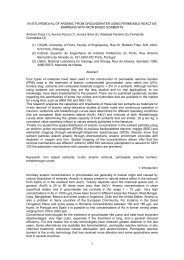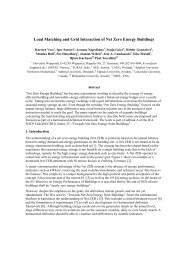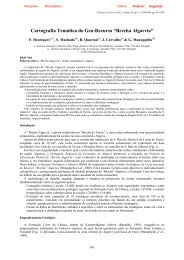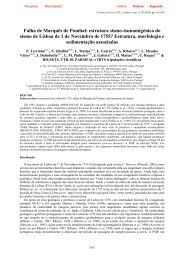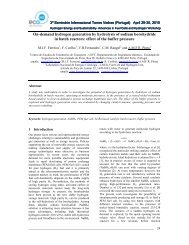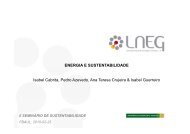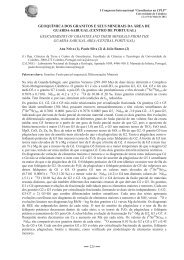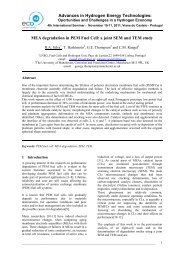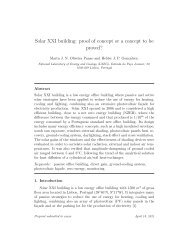Life Cycle Assessment of a Multi-Material Car Component
Life Cycle Assessment of a Multi-Material Car Component
Life Cycle Assessment of a Multi-Material Car Component
- No tags were found...
You also want an ePaper? Increase the reach of your titles
YUMPU automatically turns print PDFs into web optimized ePapers that Google loves.
Automotive Sector<strong>Car</strong> <strong>Component</strong>sWasher. The washer material is considered to be equivalentto the 'St14 I' steel as defined in Idemat 2001 database(SimaPro 6.01), while the washer production process is consideredto be equivalent to the 'Cutting steel shears' process,as described in the Data Archive database (SimaPro 6.01).However, a 20% production <strong>of</strong> waste is considered, as basedupon project partners' information. Regarding the surfacetreatment, data is obtained from the 'Phosphating (Zni) I'process included in Idemat 2001 (SimaPro 6.01).Poppet. The poppet material is considered to be equivalentto the 'EPDM rubber ETH U' as defined in the ETH-ESU1996 database (SimaPro 6.01). The poppet production processis similar to the 'Injection moulding' process, as describedin the Data Archive database (SimaPro 6.01). However,according to project data, the quantity <strong>of</strong> productionwaste considered was 60%, and the electricity consumptionby kg <strong>of</strong> output was 7.6 MJ, which includes the electricityconsumption both for vulcanisation and for injection.Poppet-retainer. The inventory data for the poppet-retainermaterial (POM) was obtained from Chalmers University <strong>of</strong>Technology [13]. The poppet-retainer production process issimilar to the 'Injection moulding' process, as described inthe Data Archive database (SimaPro 6.01) However, thequantity <strong>of</strong> production waste considered was 60% in orderto be closer to project data.The steel waste recycling process is assumed to be equivalentto the 'Recycling ferro metals' defined in the DataArchive database (SimaPro 6.01). Accordingly, an estimatedtransportation distance <strong>of</strong> 0.25tkm/kg <strong>of</strong> waste is used. ThePOM waste recycling process is similar to the activity <strong>of</strong>'Recycling plastics (excl. PVC)', as described in the DataArchive database. In this case, the transportation distanceconsidered is 0.15tkm/kg <strong>of</strong> waste, where POM is to beavoided in the product. The EPDM waste incineration processis equivalent to the activity <strong>of</strong> 'Incineration plastics (excl.PVC)', as defined in the Data Archive database (SimaPro6.01). In this treatment process, all transport distances areconsidered.Transportation distances <strong>of</strong> materials and sub-components,as referred to in Figure 1, were obtained from project data.In addition, it is assumed that such transportation is doneby a 28 tonne truck, which is represented by the 'Truck 28tB250' as defined in the Buwal 250 database (SimaPro 6.01).• Use phaseThe car component is considered to be assembled in a carequivalent to a '<strong>Car</strong> (petrol) I', as defined in Idemat 2001(SimaPro 6.01) and portraying the characteristics describedin section 2.4.• Final disposal phaseThe steel recycling process is assumed to be equivalent tothe 'Recycling ferro metals', as defined in the Data Archivedatabase (SimaPro 6.01). Accordingly, an estimated transportationdistance <strong>of</strong> 0.25tkm/kg <strong>of</strong> waste is used. The plastics(POM and EPDM) landfill process is similar to the activity<strong>of</strong> 'Landfill plastics (excl. PVC)', as described in DataArchive database (SimaPro6.01).The alternative scenario• Production phaseSpring. The spring composition is to considered to be equivalentto the '55Si7 I' steel, which is defined in the Idemat2001 database (SimaPro 6.01). The spring production processis equivalent to the 'Cold transforming steel' process,as described in the Data Archive database (SimaPro 6.01).In addition, a production waste <strong>of</strong> 2% is considered accordingto project data.Washer. The washer composition is considered to be equivalentto the 'PA 66 GF 30 I', which is defined in the Idemat2001 database (SimaPro 6.01). In this moulding process bymulti-material injection, the washer, the poppet and the poppet-retainerare made in the same mould, as the injection <strong>of</strong>each sub-component material is performed in a sequentialmanner. As a consequence, for LCA purposes, the multimaterialinjection moulding process is modelled as consisting<strong>of</strong> 3 single injection moulding processes (regarding theproduction <strong>of</strong> a washer, a poppet and a poppet-retainer, respectively).As far as the washer is concerned, its productionprocess is considered to be similar to the 'Injectionmoulding' process as described in the Data Archive database(SimaPro 6.01). In addition, according to project data,the quantity <strong>of</strong> production waste is assumed to be 60%.Poppet. The TPV composition is assumed to consist <strong>of</strong> 45%PP and 55% EPDM. It is considered that both PP and EPDMare equivalent to 'PP ETH U' and 'EPDM rubber ETH U',respectively, as defined in the ETH-ESU 1996 database(SimaPro 6.01). The poppet production process is assumedto be equivalent to the 'Injection moulding' process that isdescribed in the Data Archive database (SimaPro 6.01).However, according to project data, the quantity <strong>of</strong> productionwaste is assumed to be 60% and the electricity consumption<strong>of</strong> 2.28 MJ per kg <strong>of</strong> output.Poppet-retainer. The poppet-retainer composition is assumedto be equivalent to the 'PA 66 GF 30 I', as defined in theIdemat 2001 database (SimaPro 6.01). Its production processis considered to be equivalent to the 'Injection moulding'process that is described in the Data Archive database(SimaPro 6.01), although, according to project characteristics,a production waste <strong>of</strong> 60% is considered.The steel waste recycling process is assumed to be equivalentto the 'Recycling ferro metals' defined in the DataArchive database (SimaPro 6.01). Accordingly, an estimatedtransportation distance <strong>of</strong> 0.25tkm/kg <strong>of</strong> waste is used. ThePA6.6+30%GF waste recycling process is considered to besimilar to the 'Recycling plastics (excl. PVC)', as describedin the Data Archive database. A transportation distance <strong>of</strong>0.15tkm/kg <strong>of</strong> waste is assumed. The PA6.6+30%GF is consideredas the avoided product. Regarding the TPV wasterecycling process, a similarity with the 'Recycling plastics(excl. PVC)' is considered and, thus, described in the DataArchive database. Accordingly, the transportation distance<strong>of</strong> one kilogram <strong>of</strong> waste is taken as 0.15tkm and, in thiscase, the TPV is the product avoided.Transportation distances, described in Fig. 2, are based onproject data. It is assumed that a 28 tonne truck is usedInt J LCA 12 (5) 2007 341





